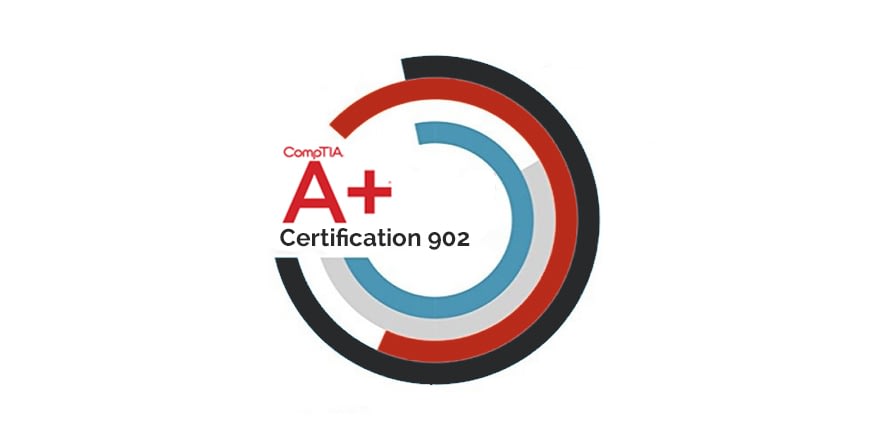CompTIA A+ Certification 902. The Total Training

CompTIA A+ Certification 902. The Total Training
Welcome to the CompTIA A+ Certification 902.
This is the second of a two course arrangement for CompTIA A+ and is intended to set you up to take and pass the CompTIA A+ 220-902 test. To turn out to be completely A+ guaranteed you should pass both the 220-901 and 220-902 tests. This course is more than 10 hours long containing more than 100 video addresses. The principal objective of the course is to make you a decent PC Tech and in the process ensure you are prepared to breeze through the CompTIA 902 test.
Chapter 1: Path of the PC Tech
1
01 – What is the CompTIA A+?
2
02 – How to Pass the A+ Exams
3
03 – What is on the 220-902?
4
04 – Why Get A+ Certified?
Chapter 2: Operational Procedures
1
01 – Professionalism
2
02 – Communication
3
03 – Three Threats to Your PC
4
04 – Physical Safety
5
05 – Equipment Safety
6
06 – Troubleshooting Theory
Chapter 3: The Visible Computer
1
01 – Touring Windows Vista
2
02 – Touring Windows 7 Part_1
3
03 – Touring Windows 7 Part_2
4
04 – Touring Windows 7 Part_3
5
05 – Touring Windows 8
6
06 – Touring Windows 10
7
07 – Touring OSX
8
08 – Touring Ubuntu Linux
9
09 – Tech Paths
Chapter 4:RAM
1
01 – RAM Sticks and Speeds
2
02 – RAM Capacity
3
03 – Virtual Memory
Chapter 5:Power Supplies
1
01 – Choosing a Power Supply
2
02 – Power Protection
Chapter 6:Implementing Hard Drives
1
01 – Understanding Patitioning
2
02 – Basic Partitioning
3
03 – Dynamic Disks
4
04 – File System
5
05 – Storage Spaces
6
Quiz 3: Implementing Hard Drives
Chapter 7:Essential Peripherals
Chapter 8:Building a PC
1
01 – Media Sources
2
02 – Windows Install Options
3
03 – Windows Upgrade Paths
4
04 – Installing Windows
5
05 – Post Installation Tasks
Chapter 9:Windows Under the Hood
1
01 – What is the Registry
2
02 – The Boot Process
3
03 – Processes
4
04 – Dealing with Processes
5
05 – Services
6
06 – Windows 8 Task Manager
Chapter 10:Users
Groups
and Permissions
1
01 – Introduction to Users and Groups
2
02 – Creating Users in Windows Vista 7
3
03 – Managing Users in Windows 8 or 81
4
04 – Sharing Folders and Files
Chapter 11:Maintaining and Optimizing Operating Systems
1
01 – The Zen of Computer Maintenance
2
02 – Patch Management
3
03 – Autostarting Programs in Windows
4
04 – Meet the MMC
5
05 – Installing and Uninstalling Programs
6
06 – Windows System Restore
7
07 – Windows Backup
Chapter 12:Working with the Command Line Interface
1
01 – Windows Command Line Basics
2
02 – Working With Folders and Files_In_Linux
3
03 – Fancy Copying
4
04 – Working with Drives
5
05 – Advanced Windows Command_Line
6
06 – Linux Command Line Basics
7
07 – Working with Folders and Files
8
08 – Linux File Permissions
9
09 – Miscellaneous Linux Commands
Chapter 13:Troubleshooting Operating Systems
1
01 – The Recovery Console
2
02 – Windows Recovery Environment
3
03 – Advanced Startup Options Part_1
4
04 – Advanced Startup Options Part_2
5
05 – Boot Problems
6
06 – Event Viewer and Action Center
7
07 – Application Troubleshooting
8
08 – Kernel Panics
Chapter 14:Virtualization
1
01 – Virtualization Basics
2
02 – Your First Virtual Machine
3
03 – Infrastructure as a Service
4
04 – Platform as a Service
5
05 – Software as a Service
6
06 – Cloud Ownership
Chapter 15:The Internet
1
01 – Internet Options
2
02 – Proxy Servers
3
03 – Troubleshooting Internet Connections
Chapter 16:Understanding Mobile Devices
1
01 – Touring Android
2
02 – Touring IOS
3
03 – Touring Windows Mobile
Chapter 17:Care and Feeding of Mobile Devices
1
01 – Cellular Configuration
2
02 – Wireless Mobile Connections Part_1
3
03 – Wireless Mobile Connections-Part_2
4
04 – Mobile Devices and Email
5
05 – Synchronization
6
06 – Securing Android Devices
7
07 – Securing iOS Devices
Chapter 18:Printers and Multifunction Devices
1
01 – Installing Local Printers
2
02 – Installing Network Printers
3
03 – Cloud Printing
Chapter 19:Securing Computers
1
01 – Physical Security
2
02 – Passwords and Aunthentication
3
03 – Protecting Against_Snoops
4
04 – Malware
5
05 – Anti malware Applications
6
06 – Anti Malware Practices
7
07 – Software Firewalls
8
08 – Hardware Firewalls
9
09 – Data Destruction
10
10 – Incident Response
Be the first to add a review.
Please, login to leave a review






